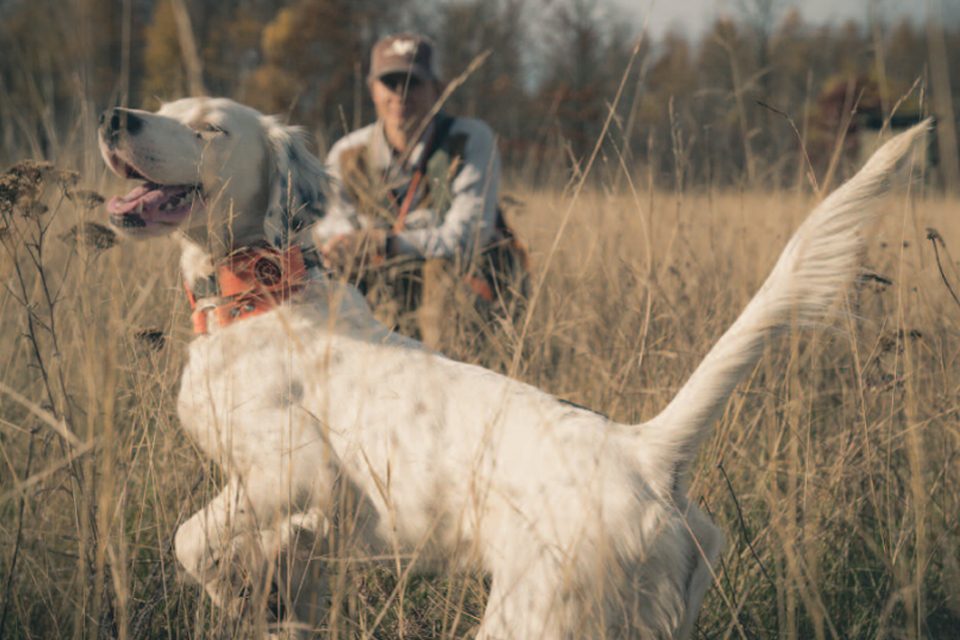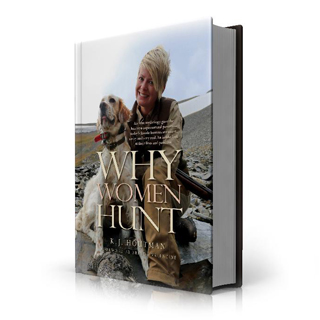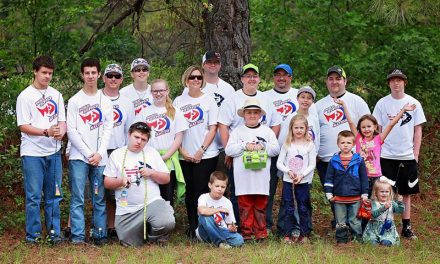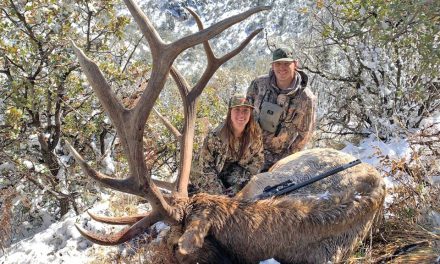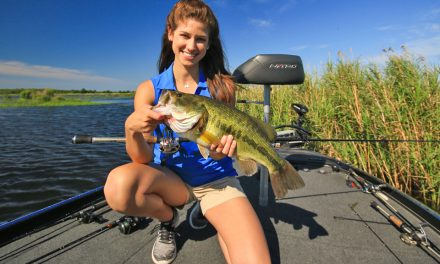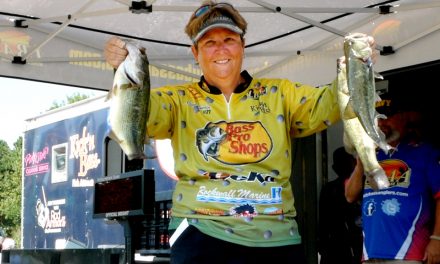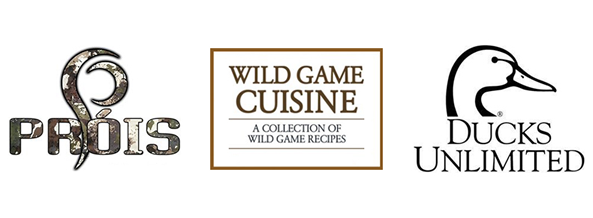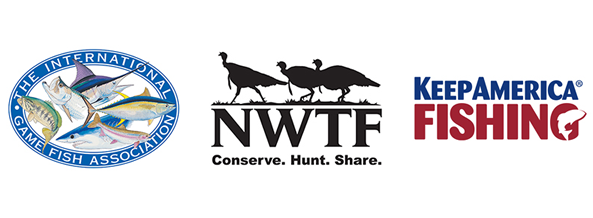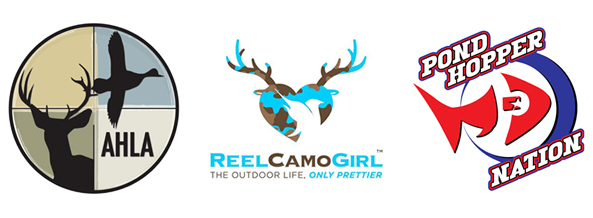(Note: This article about Meadow Kouffeld is from the book Why Women Hunt by K.J. Houtman and was excerpted with permission from Wild River Press.)
*****
Meadow Kouffeld can’t remember a time that didn’t center around hunting—some of her earliest memories include dove hunting with her father and her little sister, Maggi. “Dad called us his golden retrievers, because we were these little blonde girls, and we’d help with his dove hunting.”
Born in the Netherlands, Meadow’s father had a deep-seated passion for hunting. “It takes years to get a license, and you are only allowed to own two or three guns. It’s difficult to get a hunting lease at all, let alone a good one,” Meadow said of her father’s native Netherlands. “He moved to America as a legal alien 35 years ago and settled in northern California because he wanted to hunt. That was the main reason he moved here.”
Even though Meadow and her sister grew up hunting, there were still men-only hunting trips where the girls were shut out from participating. She knows what it feels like to be excluded. The family had livestock and raised (and showed) chickens. There was never any room financially or practically to have a bird dog; their dogs were to help with livestock or bear hunting. The luxury to hunt behind a pointer would come a bit later in life while in college at Humboldt State University.
“My friends at Humboldt were duck hunters, and one friend even had a scull boat,” Meadow said, referring to a sleek boat one lies down in for the hunt. “You can sneak into a raft of ducks. It’s an exciting and somewhat dangerous way to hunt ducks. That friend had a German wire-haired pointer named Beta, who came from great bloodlines.
From those hunts, and other women’s hunts through California Fish & Game, where Meadow was paired with a hunter and his pointing dog, she knew hunting over a pointer would be her future. I want a dog like that someday, she promised herself, even as a young college student. There was something magical about pointing, and the working dogs were fabulous to watch.
Located in northern coastal California, Humboldt State University is distinguished for its programs in natural resources. Meadow witnessed the shift from preservationist to conservationist in many fellow students. “A lot of students upon entry were very anti-hunting and vocal about it,” Meadow said. “But by the time they were done with their four years, some had become hunters themselves. Once they had an education, even from a liberal school, a lot of those students had changed.”
Eventually, Meadow moved to Minnesota to complete her master’s degree thesis on the habitat selection and ecology of ruffed grouse through the University of Minnesota. She met a breeder of Deutsch-Drahthaars through a game fair. Meadow followed the kennel over the next few years, and when the right breeding came up, she was in her final year of graduate school. It was good timing, and she put her deposit down. However, as she focused on writing her thesis and preparing to defend it, she had plenty of opportunities to doubt her decision about getting a puppy. But when the breeder called to let her know that “the puppies hit the ground,” Meadow took it as a sign to keep moving to get everything done. The clock was ticking to stay on track with her academic research and writing.
*****
Developed in Germany, the Deutsch-Drahthaars breed were founded on a cross between German short-haired pointers (Kurtzhaars), Korthals Griffons, Stichelhaars, and pudelpointers. With family connections originally from that part of the world, maybe it was a visceral perfect pairing. Eventually, Meadow picked a female and named her Meine—or maybe Meine picked her.
“The first year was all excitement, and I learned a lot from her.” Meadow did all the German-system performance testing with Meine in the first year, and Meine did great. “She had one of the highest scores in the nation—the highest score for a woman handler, for sure,” Meadow said. By the second grouse hunting season, when Meine was a year-and-a-half old, she really turned on. “Deutsch-Drahthaars are used for all sorts of things because they’re incredibly intelligent and have a lot of motivation,” Meadow said. “For me, it has been mostly hunting and water work.”
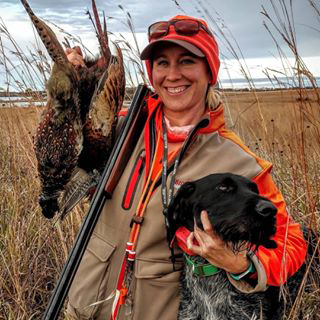 With a daughter, Heidi, now five years old, Meadow has also brought in other Deutsch-Drahthaars, and her partner has English setters, so there is a lot of pitter-patter at Meadow’s home; four big bird dogs and one little girl heading to kindergarten.
With a daughter, Heidi, now five years old, Meadow has also brought in other Deutsch-Drahthaars, and her partner has English setters, so there is a lot of pitter-patter at Meadow’s home; four big bird dogs and one little girl heading to kindergarten.
“I watched Heidi as a toddler with puppies in the whelping box as she tried to cover them with a pink blanket, but every time she’d tug on one end of the blanket, another puppy would peek out the other side.” She has a video of Heidi and the pups that Meadow watches when she needs to be reminded about what’s important in life. “I realized life is just too darn short, and I really think of it as how many dogs do I have left in my life. I wished they lived forever, but they don’t.”
*****
After a myriad of conservation projects while a student at Humboldt, Meadow worked as a fisheries and wildlife biologist in conservation and management on the west coast and then took on a desert bighorn sheep reintroduction project with the New Mexico Department of Game & Fish in the Bootheel region—true border country. Later she worked with greater sage grouse in Nevada. After completing her master’s work in Minnesota, Meadow joined the Ruffed Grouse Society as a regional biologist. However, the long work hours and many days of traveling taunted Meadow to change it up.
Though she’d joined the natural resources faculty at Itasca State College part time in 2014, Meadow decided to extend undivided attention to academia. She now leads the Wildfire Academy, hosting 900 students from various fire management professionals, as well as teaching dendrology, forest ecology, and wildlife ecology and management at the school.
*****
Meadow isn’t afraid of snakes or any critter-thing in the wild—even predators like bears or wolves—but one fear is the loss of life of a loved one or hunting peer during a hunt. “That’s my biggest fear, and it is what drove me to go to Kyrgyzstan with my sister.”
It wasn’t easy leaving young Heidi at home to trek to any ‘stan; even out-of-state hunting was uncommon for this California native as she grew up. Anything exotic was too out of reach because of the expense. “But my sister fights fires in California, and she works really hard and gets paid well,” Meadow said. The stats on early death for firefighters is significant and may lend to a bit of you-only-live-once philosophy in her sister’s life.
So Maggi put down the money and scheduled her search for an ibex. “I thought it was just outlandish,” Meadow said. “My exposure to that area of the world was that it was scary. She asked me to go along, and the more I thought about it, the more I realized I could never forgive myself if anything happened to her while she was there. I’d never live that down.”
Upon arrival in the capital city of Bishkek, the gals found themselves snowed in for several days. The delay allowed for sightseeing and a chance to mix with the locals. They found Kyrgyz people to be friendly and welcoming. After a few days, they were united with their guide and outfitter for the 25-hour gnarly trek to the hunting camp. Their guide spoke only a small amount of English.
“I thought, this can’t be real,” Meadow said. “Everyone—even the men—were very professional and respectful.” Meadow only had one view of men living in any ‘stan, and what she experienced surprised her. The guide called them “Supa,” his attempted English for “Super,” as in “Superwomen.” They knew how to mount horses without help, could ride for many hours, and hang tough in the great wilderness without complaint. Elevations were 10,000 to 15,000 feet. The “Supas” weren’t afraid and were enjoying a hunting adventure of a lifetime.
All the animals were fantastic in the Tien Shan mountain range and the Issyk-kul lake region. The experience opened Meadow’s eyes to a different view of the world than just picturesque landscapes. “Hunters are hunters regardless of where we are,” Meadow said. “We’re all motivated to care for our environment, including our wildlife resources, no matter where we live.” She likened the quote of Ernest Hemingway from Green Hills of Africa: “So, sure enough, we put up partridges and watching them fly, I was thinking all the country in the world is the same country and all the hunters are the same people.”
Meadow observed and experienced firsthand that the hunters in Kyrgyzstan cared about their animals the same as we do in America. “They’re just as passionate,” Meadow said. “There is a deep cultural connection with the animals and the landscape.” Lake Issyk-kul boasts teal-colored water with red sand beaches and snowcapped mountains in every direction. “It was beautiful. One woman in our group took a Mid-Asian ibex and a marco-polo argali, and my sister did take a Mid-Asian ibex.” Just one or two of those tags getting filled can change the financial course for several families—and even throughout the entire community. They are all motivated for the perpetuation of those animals.
“They value their game conservation, and they value the hunt,” she said. It changed Meadow’s perspective on the world and opened her to the possibilities of other hunts in other locations.
That might seem extreme, though Meadow isn’t a fan of the word “extreme.” Even so, she is a finalist in the 2019 Extreme Huntress competition. She’s not enthralled with the word “huntress” either. “I just want to be a hunter, not necessarily a woman hunter or a huntress,” Meadow said. “Sure, hunting has traditionally been a male thing, but it is getting more frequent that women do their own thing, and it is socially acceptable for women now, which opens doors for even more to be involved.”
*****
Mentoring is important to Meadow, who given her druthers, would be hunting alone and enjoying the solitude of the field or woods. “We have to open doors for new participants. We just have to.” That is one reason Meadow entered the Extreme Huntress competition.
The first time she entered the contest 10 years ago, there was a dream hunt for the winning prize. She wanted that hunt badly. Now it’s more about keeping skilled, confident, and knowledgeable women visible in the hunting world. “I want to inspire other women to stick their necks out there and do something on their own.”
The first stage of the Extreme Huntress application process is a video popularity vote and judged application. “The first years, some of the women in the finals were only guided on hunts in their past and didn’t have the skill set to work independently,” Meadow said. It was obvious from the shows that aired around the competition. That’s changed over the last 10 years as the finalists have been skilled hunters. “I’m extremely competitive—maybe to a fault—so I’ve been training to be ready to work hard in the heat of Texas and improve myself.”
At 34 years of age, Meadow has been hunting her whole life, and her hunts are rarely ever guided hunts (unless required in some places, like Kyrgyzstan and South Africa). Meadow predominantly enjoys DIY hunts. Shining the light on capable and competent women in the field is how Meadow will enter into the 2019 Extreme Huntress arena. Whether she ends up successful or not, she will step in as a true hunter.
~By K.J. Houtman
Website | Facebook | Instagram | Twitter
Do you love to fish, hunt, camp, or hike? You can count on K.J. Houtman’s books (and magazine and web-based articles) to celebrate a love for the outdoors. As a writer-member of Association of Great Lake Outdoor Writers (AGLOW), Southeastern Outdoor Press Association (SEOPA), and Professional Outdoor Media Association (POMA), K.J. ties the outdoors to everything—from children’s books to adult non-fiction. Several of her books have been awarded “Excellence in Craft” from writers within these outdoor organizations. Based in the Twin Cities of Minnesota, K.J. is a graduate of Elmhurst College in Elmhurst, Illinois.

